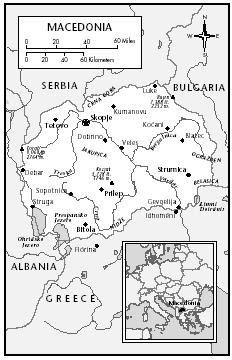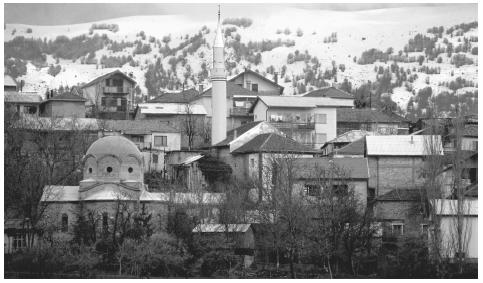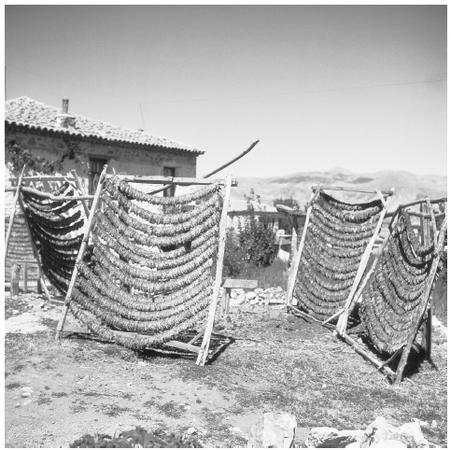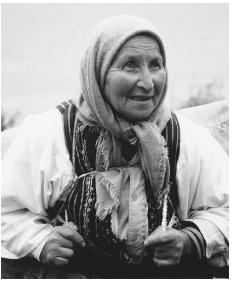Macedonia
Culture Name
Macedonian
Alternative Names
Makedonski, Slavo-Macedonian, Skopia
Orientation
Identification. The ancient Macedonians were considered non-Greek but are claimed as co-nationals by the modern Greeks. Modern Macedonians are Slavs descended from the peoples who arrived in the Balkans in the sixth and seventh centuries. There are six ethnic groups: Miyak, Brsyak, Southern, Struma-Mesta, Macedo-Shop, and Upper Vardar.
Location and Geography. Macedonia is a land-locked nation located in southeastern Europe. The current border runs along mountain chains that separate the republic from Bulgaria, Greece, Albania, and Kosovo and Serbia. Macedonia is slightly larger than the state of Vermont with a total area of 9,781 square miles (25,333 square kilometers). The country consists mostly of mountains separated by flat river valleys. The capital, Skopje, is the largest city.
Demography. In 1994, the population was 1,945,932. The population in that year was 67 percent Macedonian, 22 percent Albanian, and 4 percent Turkish, with smaller numbers of Roms (Gypsies), Vlahs (Aromanians), Serbs, Muslims, and others. The number of Macedonians in neighboring states is difficult to determine.
Linguistic Affiliation. Macedonian is a South Slavic language in the Indo-European family whose closest relatives are Bulgarian and Serbian. There is a major east-west dialectal division and about twenty subdivisions. Macedonian evolved in contact with non-Slavic languages such as Greek, Albanian, Aromanian, and Turkish. During the Ottoman period, multilingualism was the norm, but today young Macedonian speakers are more likely to know English than the other national languages. Multilingualism is common in urban areas but is less common in rural areas.
Symbolism. The unsuccessful Saint Elijah's Day (Ilinden) uprising of 1903 is the organizing metaphor of statehood. The Macedonian Peoples Republic (with Macedonian as the official language) was established in 1944. The sarcophagus of Gotse Delchev in a church in Skopje is near the site of a ceremonial commemoration that includes fireworks, picnics, and folk dancing. The national anthem refers to the sun of freedom, the struggle for rights, and the heroes of Ilinden. The first flag used after independence, featuring a yellow sixteen-pointed symbol in the center of a red field, was based on a symbol found at the presumed burial site of Philip of Macedon in Greek Macedonia in 1977. The use of this symbol infuriated the Greeks, and in 1995 the Macedonian parliament adopted a flag with a yellow circle with eight rays projecting to the edge of a red field. Other metaphors of community include "Mother Macedonia," "heart of the Balkans," and "oasis of peace."
History and Ethnic Relations
Emergence of the Nation. Byzantine documents indicate that the Slavs of Macedonia were a distinct group in the early medieval period, and Slavic dialects from Macedonia are identifiable from early Slavic documents. The modern national movement emerged in the nineteenth century. Although many Macedonians self-identified as Greeks, Bulgarians, or Serbs, a distinct sense of national identity developed from a sense of linguistic difference from Bulgarian and Serbian. Owing to Greek, Serbian, and Bulgarian territorial claims, Macedonian claims to nationhood were ignored until the end of World War II, when a Macedonian republic was established within the Yugoslav federation. That republic adopted an independent constitution on 17 November 1991.

National Identity. At the beginning of the nineteenth century the primary source of identity was religion, but the focus shifted to language before the end of the century. As the modern Bulgarian and Serbian literary languages took shape, Macedonians attempted to create a literary language based on their speech, but Macedonian did not receive official recognition until 1944. It is claimed that a Macedonian national identity arose during World War II to keep Yugoslavian Macedonia separate from Bulgaria, but there is documentation that the development of a national identity was indigenous in the nineteenth century.
Ethnic Relations. Ethnic Macedonians live in contiguous parts of Bulgaria, Greece, and Albania, and Muslim speakers of Slavic dialects classifiable as Macedonian who consider themselves to have a separate ethnicity (Goran) live in Kosovo and Albania. Albania recognizes as Macedonian only the Christians living in its southeast, omitting the Macedonian-speaking Muslim and Christian population of the eastern highlands and the Gorans. In 1999, Bulgaria recognized the independent existence of the Macedonian literary language, but in return Macedonia has renounced support for the Macedonian minority in Bulgaria. Greece claims to have no national minorities and thus does not recognize the existence of its Macedonian minority. In Greek EU-funded minority language projects, Macedonian has never been included. Within Macedonia, religion is as important an organizing principle as language: Most Macedonians, Serbs, and Aromanians (Vlahs) are Christian, and most Albanians, Turks, and Rom are Muslim. The national culture is identified with the Macedonian Orthodox Church, and Macedonian-speaking Muslims are divided among those who self-identify as Macedonians on the basis of language and those who self-identify as Muslims.
Urbanism, Architecture, and the Use of Space
The traditional culture is rural, but today more than 60 percent of the population is urban, with a quarter of the national residents living in metropolitan Skopje. Traditional architectural influences are Mediterranean, Byzantine, and Ottoman. Modern high-rise apartment blocks have a balcony, which often is used for storage and clothes drying. A traditional Muslim household has separate rooms for male and female guests, whereas a Christian house has a single room. In older urban neighborhoods, individual single-story rooms open into a central courtyard. Wealthier traditional urban houses have one or more upper stories projecting over the street. Urban areas are characterized by a historical center with an open bazaar. Skopje was almost entirely destroyed by an earthquake in 1963. The old main train station, torn in half with its clock stopped at the moment of the quake, was reinforced and left standing as a monument to the disaster. Many public monuments commemorate those fallen in World War II or Ilinden. Since 1991, many villages have restored or built new churches or mosques.
Food and Economy
Food in Daily Life. Breakfast is eaten around nine a.m. by workers in offices, but earlier by factory workers, and in the field in the country. Dinner is the main meal and is eaten at around two p.m. Supper is eaten later after the afternoon siesta. Meals are prepared immediately before consumption, although they may include leftovers. Hot food often is allowed to cool to room temperature. Breakfast can consist of bread and cheese, sometimes with eggs. Other meals can begin with meze (appetizers) served with rakia (fruit brandy). Bean casserole (tavche-gravche) is the national dish, and bread is considered the most basic food. In restaurants, pizza is especially popular. Hotel restaurants are popular venues for banquets, and there are many private restaurants. There are no food taboos other than those associated with religion, but folk beliefs about food abound.
Food Customs at Ceremonial Occasions. Among Christians, a bird is eaten for Christmas, and lamb for Easter. Among Muslims, a lamb is slaughtered for Kurban Bayram. At Christmas Eve dinner it is traditional to serve a cake with a coin in it. Sweet desserts are associated with religious holidays, New Year's Day, births, weddings, and funerals and commemorations. Blaga rakia (hot sugared fruit brandy) is served by the parents of the groom the morning after the wedding night if the bride is found to have been a virgin.
Basic Economy. The traditional economy was agricultural and pastoral. The nation is now industrialized and has been integrated in international trade.
Land Tenure and Property. Traditionally, land was held in common by the extended family, which was patrilocal and was defined patrilineally. After the division of property, wells and threshing floors often continued to be used collectively. Each village has a boundary that is the basic level of property division above that of the family. During the communist period, private property rights were restricted.
Commercial Activities. Cash crops include sugar beets, sunflowers, cotton, rice, tobacco, grains, fruits and vegetables, opium poppies, wine, livestock, dairy products, fish, and hardwoods. There is a tourist industry and a traditional crafts industry.
Major Industries. Steel, cement, mining, textiles, pharmaceuticals, petroleum products, and furniture making are the largest industries.
Trade. Exports include food products, tobacco, pharmaceuticals, and textiles. Serbia was the major trading partner before the imposition of international sanctions. Other important major trading partners include the former Yugoslav republics, other Balkan states, and the European Union.
Division of Labor. Labor is primarily based on agriculture, mining, and light industry. There were about one million persons in the labor force in 1998. In 1996, 38.8 percent of the labor force could not find employment. The minimum age of employment is fifteen years.
Social Stratification
Classes and Castes. Differences in the distribution of wealth have increased since 1991, with Roms at the bottom. Other social differences result from differences between urban and rural populations. Serbs and Aromanians are well integrated into the economy, while Albanians are underrepresented in the state sector.
Symbols of Social Stratification. Ethnicity is more important than class. Dress and behavior are likely to follow ethnic lines, although national costumes and articles of clothing have become less common as a result of increasing urbanization and modernization.
Political Life
Government. Macedonia is a parliamentary democracy. Macedonia's unicameral assembly of one-hundred twenty seats is called the Sobranje. The executive branch consists of the President (elected by popular vote) and the Council of Ministers (elected by the majority vote of all the deputies in the Sobranje).
Leadership and Political Officials. Political parties tend to follow ethnic lines and draw their leaders from educated elites. The main exceptions are parties led by former communists, which tend to be multiethnic. Personal connections are an important aspect of political life.
Social Problems and Control. The revision of the legal system after the communist period is not complete. Police brutality can take on ethnic overtones. Albanians are significantly underrepresented in the upper ranks of the security structure. The lack of independence of the judiciary from the political system is a perceived problem. Informal social control involves the family, gossip, saving face, and the threat of vengeance. Violent crime is rare.
Military Activity. The army is small and has outdated equipment, although it is in the process of modernizing, especially since 1999. Macedonia's security has been guaranteed by international troops since January 1993. The most important military activity is protecting the country's borders.
Social Welfare and Change Programs
The state provides social welfare to needy families and grants pensions to retirees.

Nongovernmental Organizations and Other Associations
Macedonia has numerous foreign and domestic nongovernmental organizations. The boundaries between local organizations, cultural associations, and political parties is fluid.
Gender Roles and Statuses
Division of Labor by Gender. Men and women work outside the home, but women are responsible for most domestic labor. In academia, men dominate in the sciences and engineering, whereas women are more visible in the humanities.
The Relative Status of Women and Men. In principle, the genders are equal. In practice, men have higher status, and women are likely to manage the household. Women occupy some positions of power but their representation is not in proportion to their numbers.
Marriage, Family, and Kinship
Marriage. Traditionally, marriages were arranged by the parents, but today young people are likely to choose their own partners. Pregnancy often leads to marriage among urban youth, but in the traditional culture the bride is expected to be a virgin. Traditional marriages usually do not cross religious lines. Polygyny occasionally occurs among Muslims. Marriage is the norm, and adults who have never been married are rare. Divorce and remarriage are regulated by civil law.
Domestic Unit. The traditional unit is the patrilocal extended family consisting of a married couple, their unmarried daughters, and their sons with their own spouses and children. This is becoming increasingly less common in urban areas. Children tend to live with their parents until they are married.
Inheritance. Traditionally, inheritance goes through the male line except for what women take with them as a dowry. Today children inherit equally or by assignment.
Kin Groups. Traditionally, above the level of the family or extended family there was the exogamous clan. In rural areas, a clan often constituted a hamlet within a village. The church, however, allows intraclan marriage after three generations.
Socialization
Infant Care. Infants are swaddled and carried, and sleep in cradles. They do not have separate play

Child Rearing and Education. Children are looked after by their mothers, grandmothers, neighbors, or older siblings. Children play freely at an early age. Boys are expected to be more active than girls. In urban areas there are also nursery schools and kindergartens. Eight-year elementary education is compulsory.
Higher Education. Society places a high value on higher education, but ethnic minorities are under-represented. Approximately 87 percent of those holding university degrees are ethnic Macedonians.
Etiquette
In the traditional culture, the young show deference to the old. It is normal for male friends to shake hands and for women to kiss when meeting and saying good-bye. A person entering a room where others are seated will shake hands with each person. Physical contact among friends of the same gender is considered normal. Although staring at strangers was once common, it became relatively rare in the 1990s. It once was the norm to remove one's shoes at the entrance of a home, but this practice is receding among urban Christians.
Religion
Religious Beliefs. The major religions are Orthodox Christianity (66 percent) and Islam (30 percent), with small groups of Roman Catholics, Protestants, and atheists. Most Jews were deported and killed by the Nazis, but a few still live in Macedonia. Belief in the evil eye is widespread, and religious practices in rural areas often reflect folk beliefs.
Rituals and Holy Places. Rituals take place at the church or mosque, at the cemetery, in the village, and at home. The most important holidays are Christmas and Easter for Christians and Ramadan and Kurban Bayram for Muslims. Among the Rom, Saint George's Day on 6 May is the major holiday. The Aromanians celebrate 20 May as the Day of the Vlahs, to commemorate the Ottoman recognition of a separate Aromanian church (and therefore millet "nationality") in 1905. Among the customs still practiced are the lighting of bonfires and the singing of special songs on Christmas Eve. Traditionally on the Feast of the Epiphany, a cross is thrown into a major body of water to bless it for the new year.
Death and the Afterlife. Relatives visit the grave on the third, ninth, and fortieth days after the burial; after six months; and after the first year to mourn, give out food, light candles and incense, and pour libations of water or wine. An unmarried young person is buried dressed for a wedding. Among folk beliefs are various practices to prevent a corpse from becoming a vampire.
Medicine and Health Care
Medicine is modern, but there are also the traditional folk healers, normally old women, who deal with mysterious illnesses such as warts and maladies caused by the evil eye.
Secular Celebrations
Official holidays include the New Year on 1 and 2 January, Orthodox Christmas on 7 January, Easter Monday, the International Day of Labor on 1 and 2

The Arts and Humanities
Support for the Arts. The arts are supported by the state through the Macedonian Academy of Arts and Sciences, institutions of higher learning, and public theaters. Despite its small size, Macedonia boasts thirteen active professional theater groups that average over sixteen hundred total performances per year, a philharmonic orchestra (established in 1944), six chamber ensembles, and a host of annual folk music festivals.
Literature. Modern Macedonian literature made its appearance during the late 1800s with the poetry of the brothers Dimitar and Konstantin Miladinov, whose works are still recited by students. The growing literary collection grounded in the current, or codified, standards of the Macedonian language, on the other hand, marks its beginning with the 1939 publication of Kosta Racin's programmatic collection of poems entitled Beli Mugri (White Dawns). While most of the distinguished nineteenth and early twentieth century literary figures were poets, since the end of World War II there has been an increase in the number of prose writers and playwrights.
Graphic Arts. Villagers in Macedonia are known for their weaving of colorful blankets and carpets. Gold and silversmiths are plentiful in the bazaars of larger cities, and stomnari, or urn-makers, still produce glazed terra cotta utensils such as urns, pitchers, cups, and bowls.
Performance Arts. Since gaining independence, Macedonia has produced a number of promising film directors whose pictures have acquired international recognition and praise. The film Before the Rain, for example, was nominated in 1994 by the American Film Academy for the Best Foreign Language Film Award. It had already won the Golden Lion award at the Venice Film Festival.
The State of the Physical and Social Sciences
The Macedonian Academy of Sciences and Arts, founded in 1967 at Skopje, has sections of biological and medical sciences and of mathematical and technical sciences. The country also has an Association of the Sciences and Arts, founded in 1960 at Bitola, as well as specialized learned societies concerned with physics, pharmacy, geology, medicine, mathematics and computers, veterinary surgery, engineering, forestry, and agriculture. Macedonia has research institutes dealing with geology, natural history, cotton, animal breeding, tobacco, animal husbandry, and water development.
The University of Skopje (founded in 1949) has faculties of civil engineering, agriculture, veterinary medicine, forestry, medicine, pharmacy, mechanical engineering, electrotechnical engineering, technology and metallurgy, natural and mathematical sciences, stomatology, and geology and mining. Between 1987 and 1997 science and engineering students accounted for 47 percent of university enrollment. During that same period, Macedonia had 1,335 scientists and engineers and 546 technicians per million people engaged in research and development. The Natural History Museum of Macedonia (founded 1926) is located in Skopje.
Bibliography
Arbatski, Yuriy. Beathing the Tapan , 1953.
Barker, Elizabeth. Macedonia: Its Place in Balkan Power Politics ,1950.
Borden, Anthony, and Ibrahim Mehmeti, eds. Reporting Macedonia: The New Accommodation , 1998.
Brailsford, H. N. Macedonia: Its Races and Their Future , 1906.
Brown, Keith S. "Of Meanings and Memories: The National Imagination in Macedonia." Ph.D. dissertation, University of Chicago, Chicago, 1995.
Byrnes, R. F. ed. Communal Families in the Balkans: The Zadruga , 1976.
Chashule, Vangja ed. From Recognition to Repudiation: Bulgarian Attitudes on the Macedonian Question , 1972.
Danforth, Loring. The Macedonian Conflict: Ethnic Nationalism in a Transnational World , 1995.
Ford, George H. "Networks, Ritual, and 'Vrski': A Study of Urban Adjustment in Macedonia." Ph.D. dissertation, Arizona State University, Tempe, 1982.
Friedman, Victor A. "Macedonian Language and Nationalism during the Nineteenth and Early Twentieth Centuries." Balkanistica 2: 83–98, 1975. (Reprinted in Macedonian Review 16 (3): 280–292, 1984.)
——. "The Sociolinguistics of Literary Macedonian." International Journal of the Sociology of Language 52: 31–57, 1985.
Hall, Jonathan M. Ethnic Identity in Greek Antiquity , 1997.
Ilievski, Petar. "The Position of the Ancient Macedonian Language and the Modern Name Makedonski ." Balkanistika 10: 227–240, 1997.
Kramer, Christina. Macedonian: A Course for Beginning and Intermediate Students , 1999.
Lazarov, Risto. This Is the Republic of Macedonia , 1993.
Liebman, Robert. "Wedding Customs in the Ohrid Village of Peshtani." Makedonski Folklor 9–10: 125–240.
Lunt, Horace. "Some Socio-Linguistic Aspects of Macedonian and Bulgarian." In: B. Stolz, I. Titunik, and L. Dolezel, eds., Language and Literary Theory , 1984.
——. "On Macedonian Nationality." Slavic Review 45:729–734, 1986.
Miloslavlevski, Slavko. Fakti za Makedonija , 1996.
Perry, Duncan M. The Politics of Terror: The Macedonian Revolutionary Movements 1893–1903 , 1988.
Poulton, Hugh. Who Are the Macedonians? , 1995.
Radin, A. Michael. IMRO and the Macedonian Question , 1993.
Rossos, Andrew. "The British Foreign Office and Macedonian National Identity 1918–41." Slavic Review 53: 369–394, 1994.
——. "Incompatible Allies: Greek Communism and Macedonian Nationalism in the Civil War in Greece,1943–49." Journal of Modern History 69: 42–76, 1997.
Roudometoff, Victor, ed. The Macedonian Question: Culture, Historiography, Politics , 1999.
Rubin, Barnett, ed. Toward Comprehensive Peace in Southeastern Europe: Conflict Prevention in the South Balkans , 1996.
Sachs, Nahoma. "Music and Meaning: Musical Symbolism in a Macedonian Village." Ph.D. dissertation, University of Indiana, Bloomington, 1975.
Stardelov, Georgi, Cvetan Grozdanov, and Blazhe Ristevski, eds. Macedonia and Its Relations with Greece , 1993.
Statistical Office of Macedonia. The 1994 Census of Population, Households, Dwellings and Agricultural Holdings in the Republic of Macedonia, 1996–1997.
Tomovski, Krum, Galaba Palikrusheva, and Angelina Krsteva, eds. Ethnology of the Macedonians , 1996.
Wilkinson, H. R. Maps and Politics: A Review of the Ethnographic Cartography of Macedonia , 1951.
—V ICTOR A. F RIEDMAN
Robert Jupiter
Thanks,
Sandy
If you look at a map of Macedonia during the time of Alexander the Great you will see that Greece was actually a part of Macedonia, not the other way around. No devision needs to be made in the scientific world to conclude that.
I think the same as Mr. Robert, no statement should be made until a final desicion is taken.
Macedonian
Thanks for reading!
xxx Jasmina
Sincerley,
Jasmine
Please you must see these great results.
DNA is last word with no discussion.
Good day,
Boban P. Barbarre